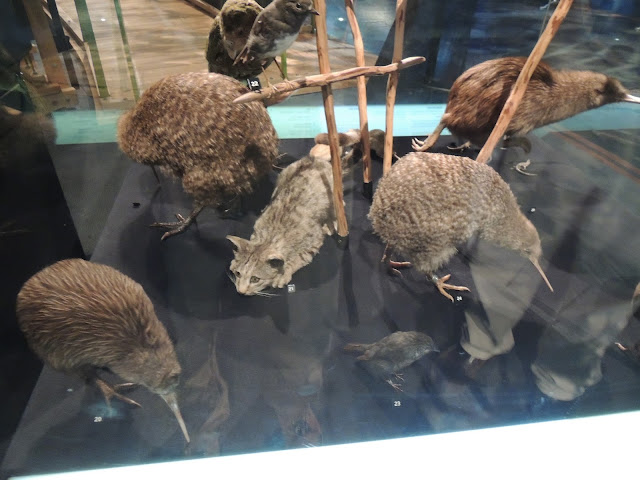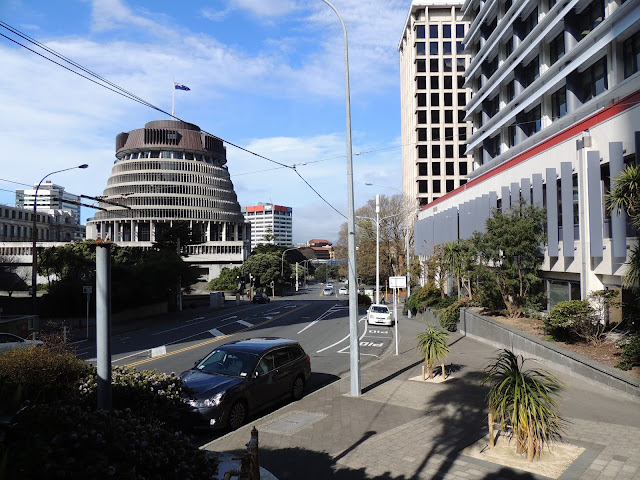The idea of the waharoa, or gateway, is particularly meaningful at Te Papa. Two important waharoa are on display – a contemporary one on The Marae and a traditional one in Wellington Foyer. The entire Museum is also a waharoa – a gateway to New Zealand’s natural and cultural heritage.
Naturally, we gravitated toward this exhibit first.
Skeleton of an immature pygmy blue whale
Look at the size of these iconic flightless kiwis. That feral cat would barely stand a chance.
This was a fun interactive touchscreen graphic showing depth of the sea. I had a little help from a young scientist who took me through it.
Actual size
Look at this piece of granite! It comes from Karamea, home to the Oparara, and we have good memories of our visit.
This exhibit was eye-opening, showing the changes wrought from the first human visitors through today.
They were lining up for Gallipoli.
The poison 1080 is a huge issue here. We seen signs protesting its use across the country.
Watercolor of Te Pehi Kupe, with moko (facial tattoos) and wearing European clothing, ca 1826, by John Sylvester. Te Pehi was paramount chief of Ngati Toa, an iwi (Maori tribe) that took over another tribe's power base. They retaliated by killing 60 people, including four of Te Pehi's children. In 1824, he peacefully boarded the Urania looking for guns to avenge the killings. There were none, though, and he decided to travel with the boat to England and ask the king for weapons. He actually was presented to King George IV, who offered gifts of food and clothing, which Te Pehi sold for weapons in Sydney. (Some stories never change.)
Maori woman wearing pounamu necklace and flax-trimmed dress
We could have spent days in Te Papa, but the cable car from a main street to the Botanic Garden awaits. A $4 fare one-way to the gardens, the return a graceful walk back into town.
And a handsome station at the top.
The gardens were bursting with spring buds.
Moreton Bay Pine
Monkey Puzzle
Chinese Saucer Magnolia
On the descent, we walked through Bolton Street Cemetery. According to the information provided:
The history of colonization is captured in the headstones. Those buried include soldiers of regiments charged with defending the new colony, large settler families, politicians and community leaders who were shaping the future of this far-flung colony, and several eminent Maori. Deaths from disease, accident, and skirmish recall the difficulties citizens faced.
The Botanic Garden walkway wends its way down to the Parliament buildings we visited yesterday.
Past time for lunch, and Vietnamese/Paris fusion seems right.
For me, a Falling Water (vodka, mint, lychee) and for Art the Mango Mekong (dark rum, mango, coconut, lime). It's been a beautiful day. The food here was excellent too.
On Saturday the Rugby World Cup opening ceremony and first match will be broadcast here live at 6 am from England (what, you didn't know?). In honor of this, NZ has lifted drinking laws to provide for round-the-clock serving. We'll be departing Wellington before too many elbow bends can be achieved, heading north for we're-not-sure-where. But we'll be rooting for the All Blacks in absentia.
More here...
Queen Elizabeth, a guest of honour at the opening ceremonies of the London 2012 Olympics and the 2014 Commonwealth Games, has decided to stay on holiday in Balmoral despite being the patron of the Rugby Football Union. Instead Prince Harry, as the vice-patron, will
represent his grandmother, along with the Duke and Duchess of
Cambridge, ahead of England's opening match against Fiji.










































I have no idea if you still check this, but what is the name of the person who took the photographs of Te Papa? I want to use one for an academic paper (I'm a student) but can't find the author's name to cite it.
ReplyDelete